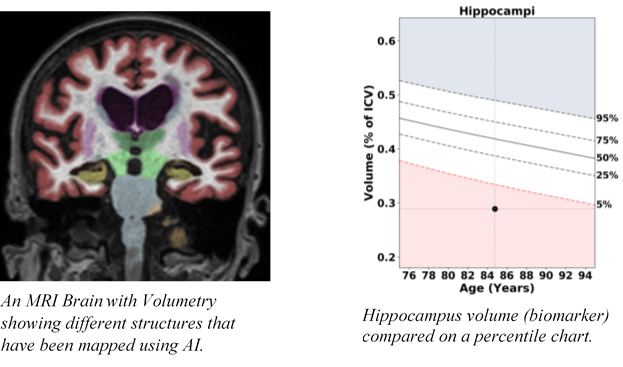SHARES
February 02, 2022
1374

by Joanne Lee
Multipotentialite. Loves creating and seeing ideas come alive. View all articles by Joanne Lee.

People with memory loss or suspected dementia often undergo an MRI to exclude tumors and vascular malformations. The results of these MRIs are usually unremarkable. However, we can now obtain imaging biomarkers using visual rating and artificial intelligence (AI) to measure regional brain volumes implicated in dementia.
The earliest presenting symptom of a person suffering dementia is often memory loss. However, brain changes begin even before memory loss happens. These changes usually start with the deposition of abnormal proteins in the brain, followed by reduced brain metabolism. Finally, the brain wastes away (atrophy) due to tissue destruction.
In 2011, the National Institute of Aging and the Alzheimer’s Association updated the guidelines for the diagnosis of dementia due to Alzheimer’s Disease. They added imaging biomarkers to the guidelines, which included hippocampus volume and rate of brain atrophy. Detecting atrophy in these structures can help in the early detection of dementia.

Measurement of brain volumes (brain volumetry) using AI allows us to overcome interobserver variability that arises from visual rating of the brain. It also further enhances the information obtained from an MRI scan of the brain. Benefits of brain volumetry include early detection of brain atrophy and measuring subtle changes over time. Plotting the volumes on a percentile chart can show if the brain volumes are within the normal limits of healthy individuals. Brain volumetry documents the results objectively and meaningfully so that physicians have quality information to for diagnosis.
The European Society of Neuroradiology published a paper in 2019 of a survey done with 193 centers across 28 countries. Primary evaluation of suspected dementia often uses brain imaging, and 72% of them were MRIs. Visual rating was used in 75% of studies, and volumetric analysis was used in 23%. Factors that limited the use of volumetry in this survey included lack of experience, lack of access, and time-intensive. The two most examined brain regions in volumetry were the hippocampus and total brain volumes, corresponding to the abovementioned guidelines. More than 50% of imaging requests were from specialists, including psychiatrists, neurologists, and geriatricians. One-third of the imaging requests were from primary care physicians.
Another imaging modality for dementia is PET imaging. It has a higher sensitivity in evaluating dementia because it detects metabolic changes that occur before structural changes. However, brain volumetry is preferred as a primary evaluation imaging tool because it shows comparable results to PET imaging with the added advantage of obtaining the results of a standard MRI brain simultaneously. Also, most patients with clinical symptoms would have structural changes if the underlying cause was dementia. Thus brain volumetry should be part of routine brain imaging in the primary evaluation of a patient suspected of dementia or suffering memory loss.

Imaging biomarkers for dementia can be obtained from MRI imaging of the brain. MRI brain volumetry with visual rating is the first step in a patient’s imaging journey. It is a convenient tool as it does not require radiation or IV injection, and there is no additional scan time for a patient already planned for a brain MRI. In addition, it provides the most comprehensive and relevant information in a first-line imaging test.
Farrer Park Hospital Singapore contributed this article. Read the original article here.
This article was reviewed by Dr Santhosh Raj (Neuroradiologist & Neurointerventionalist at Farrer Park Hospital).
———————————————————————————————————————
Find, Call or Book an appointment with a Radiologist in Malaysia, on GetDoc
Find, Call or Book an appointment with a Radiologist in Singapore, on GetDoc
Important: The team at GetDocSays have made extensive and reasonable efforts to ensure that medical information is accurate. They further ensure that the content conforms to the standards of the publication. However, they reflect the opinions and views of the contributors and not the publisher.
The information on this site is not professional advice nor to replace personal consultation with a health care professional. The reader should not disregard medical advice or delay seeking it because of information published here.
Multipotentialite. Loves creating and seeing ideas come alive. View all articles by Joanne Lee.




